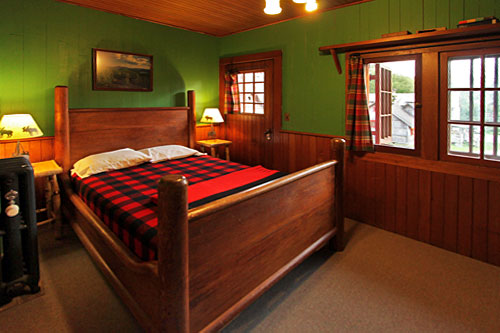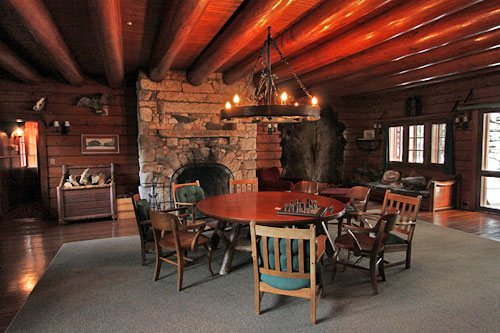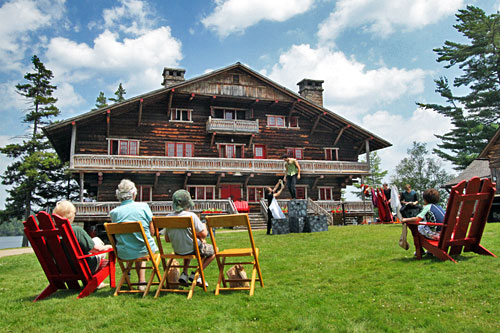I swung the door wide and surveyed the rustic room at Great Camp Sagamore that would be my home for the next three days. Rich leaf green walls topped pine wainscoting and a red and black checked quilt was deftly tucked into the sides of the heavy wooden cradle bed. Anxious to dive in for a late afternoon nap, I held my hand out for the key.
“There’s no locks on any of our doors,” the caretaker explained. Paranoia took over. How would I secure my laptop and other electronic equipment when I was out of the room? Seeing my alarmed expression, he assured me that they had never had a problem and promptly left.

The lack of locks at Great Camp Sagamore is a holdover from the days when the facility had been the private summer home of the Vanderbilt family. Alfred Gwynne Vanderbilt purchased Sagamore in 1901 from railroad tycoon William West Durant, who had completed the “camp” just four years earlier in the tradition of grand family compounds built in the latter half of the nineteenth century in the Adirondack Mountains of upstate New York. Alfred’s wife preferred the comfort of their glitzy Newport, Rhode Island mansion to Sagamore. Alfred, however, spent a great deal of time at Sagamore, which was soon expanded to include a casino and the “Wigwam,” a separate lodge constructed a discreet distance from the main lodge, where male guests could enjoy the company of ladies of ill repute. The latter was likely a factor in the couples’ scandalous divorce in 1908.
In 1911 Alfred married Margaret Emerson McKim who, unlike his previous wife, shared his enthusiasm for the outdoor life. Though Alfred died in 1915 when he sailed on the ill-fated Lusitania cruise ship, Margaret continued to entertain at the camp for many more years, earning it the nickname “playground of millionaires.” After World War II Margaret’s use became infrequent and she donated it to Syracuse University. Eventually, it was purchased by the State of New York, which transferred the property to a not-for-profit institution that now operates the historic property as a lodge.

Today Great Camp Sagamore looks much as it did back in the Vanderbilt days. In the main lodge a regal fireplace constructed from local stone soars to the ceiling, where it meets enormous burnished pine vigas that glow in the soft yellow lamplight. Bedrooms line the second and third floor halls, punctuated by a series of bathrooms shared by guests, just as they would have been when the house was full of Vanderbilt summer guests. Scattered around the grounds are smaller cottages that were built for specific family members, a communal dining room, conference centers, and even a private bowling alley, which was all the rage in the early 20th century.
My stay at Great Camp Sagamore coincided with their “Grands Camp.” Grandparents, with their grandchildren in tow, participated in a week long program of music, canoeing, swimming, hiking, crafts, singing, campfires, talent shows and workshops with Dan Duggan, one of the country’s finest hammer dulcimer musicians. The kids were in their glory, jumping into canoes each morning for a paddle on Sagamore Lake, while the grandparents cheerfully struggled to keep up. But when the kids were forced to sit through a performance of Romeo and Juliet on the front lawn one afternoon one little girl grouched, “I didn’t understand a word they were saying.” The adults smiled secretly; revenge was sweet.

For a better view of some of the most famous “camps” in the Adirondacks, one evening I hopped aboard the WW Durant for a dinner cruise on Raquette Lake. We sailed past great camps built for Governor Phinneas Lounsbury of Connecticut, the Robert Collier publishing family and the Carnegie family, as Captain Dean Pohl narrated the history of this golden age of the Adirondacks. Many of the camps fell into disrepair when their wealthy owners passed away or lost their fortunes in the Great Depression but thankfully most have been purchased by institutions that restored them to their former glory.

When my three days at Great Camp Sagamore drew to a close, I gathered up my possessions, which had sat unmolested in my unlocked room the entire time, and headed for White Pine Camp, another of the great Adirondacks camps. The camp manager showed me to my cabin, one of six that sat atop a high ridge overlooking two-mile long Osgood Lake. I scanned the delightful living room, with its Franklin stove, antique tables, and polished wood floors and quickly stashed my bags, hoping to get a walk in before the sun went down.

I held my hand out for the key and smiled when Anne shook her head. “Let me guess; you don’t have keys here?” Without a second thought I drew the door closed and strolled down the grassy hill to the lake. Late afternoon sunlight filtered through tall pines, dappling the thick grass that crushed beneath my feet. I paused inside the boathouse to read about the history of this camp, which served as the summer White House for President Calvin Coolidge in the 1920’s, then collapsed into an Adirondack chair on the dock as a flaming sun sank toward the horizon. Trees sparkled like emeralds strewn along the cobalt shore and reflected in the mirrored surface of the lake. Movement near the shore caught my eye and I glanced up just in time to see a curious ferret poke his head above the edge of the dock to examine the intruder before scampering into the underbrush.
Can’t view the slide show about the Great Camps of the Adirondacks? Click here.
Back on my screened porch, I wrapped up in a thick quilt as the sun disappeared and temperatures dropped, watching a banner of shining stars unfurl across the pitch-black sky. When the chill permeated to my bones I padded off to bed and snuggled under layers of blankets. My last thought before I drifted off to sleep was how incredibly quiet the woods were. White Pines Camp was so peaceful and restful that I hated to leave, but the rest of Adirondack Park was calling. Once again I gathered my bags and drove away, leaving the door wide open and marveling that there are still places like this in the United States where no one locks their doors.
Adirondack Park kindly hosted the author’s visit to the Adirondacks in upstate New York. However, the receipt and acceptance of complimentary items/services received will never influence the content, topics, or posts in this blog. I write the truth, the whole truth, and nothing but the truth.

this is amazing post
Property dealer in Delhi
amazing and beautiful location in picture s
Great article Barbara, I heard of the Grand Camp never had a chance to go, will definitely love to visit one day.
Hi Blade – if you get a chance, go. The Adirondacks are so lovely!
nice pics
Not having locks seems so strange. I just adore the beauty of the place from your series and the rustic houses that seem so suited to the area. I stayed in a small village in Belgium some years ago when in discussion with one of the local folks, he volunteered that no-one locks their doors here as everyone trusts each other. He was as mystified why people lock their houses as I was as to why they wouldn’t. I bet he leads a more relaxed life…
Mark, I’ll bet you’re right! Gave me my smile for the day.
Ohhh – the place looks lovely! Would love to go there in the fall when the leaves change! The picture of sunset on the lake is my favorite!
i can’t tell you how wonderful these two places look, Barbara. I’m worn out from an unbroken string of triple-digit days and endless drought.
Hi Ruth: So good to hear from you. I’m feeling pretty worn out myself so I can definitely relate. Being in the U.S. is what does it to me – so much stress here and no one seems very happy – not to mention how expensive it is to live here! The Adirondacks were a refreshing respite for me.Though they’re definitely not the Rockies, I found this area of the world to be fascinating and serene. Stay well, and I’ll pray for rain :-). Hugs.
This is way too cool! Hope I can visit one day
Wow, that’s a gorgeous Lodge. Just like in a movie scene 🙂
I’ve stayed at cabins in West Virginia several times that didn’t have any locks. It was an unusual feeling, ironically enough because it was so isolated. Makes it actually feel less secure while it’s probably the opposite!